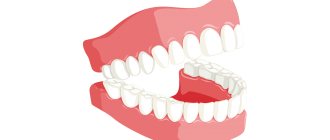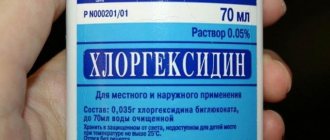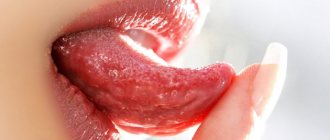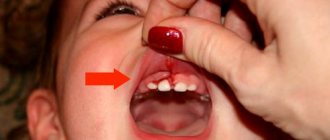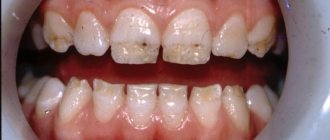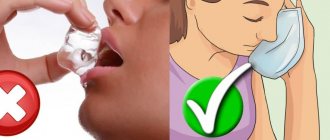Like any part of our body, our gums can also become injured. The tactics of the planned treatment depend on the volume and nature of the damage received. Only with properly organized treatment will trauma to the gums not leave serious consequences. When any oral disease appears without the necessary treatment, manifestations of a weakened body and complications are possible.
Despite the fact that the gums are protected from the outside by the muscle tissue of the lips, they are easily exposed when talking, eating, or laughing. This is facilitated by the fact that facial muscles in humans are quite well developed. Therefore, gums can easily suffer injuries of varying severity.
Why does pain occur?
Soft tissue may hurt due to:
- Enlarged lymph nodes
- A wisdom tooth that is starting to erupt
- Getting food between teeth
- Injuries received as a result of a fight, blow or bad fall
- Suppuration.
One of the causes of pain is injury. In dental practice, they are usually divided into two categories:
- Mechanical damage to the gums. A fairly common type that occurs in both adults and children. The reasons can be very diverse, but they are all related to physical effects. Falls or impacts may cause damage in one way or another. People often injure the soft tissues of the oral cavity and teeth during sports activities. Mechanical injuries are easier to diagnose because their presence can be determined visually during an examination by a doctor. They are accompanied by swelling, bruising and bleeding. An experienced dentist will help solve the problem, write out prescriptions, and select appropriate medications.
- Chemical. This category includes injuries caused by exposure to harsh chemicals. There are situations when a person, in a hurry and confused, drinks vinegar instead of water, resulting in a burn to the oral cavity. Exposure to various acids will inevitably lead to serious consequences. Teeth also suffer.
Causes of gum inflammation
Sore gums
The inflammatory process in the oral cavity develops against the background of several factors:
- Weakening of the immune system and proliferation of pathogenic bacteria. At risk are young children and adults who have had influenza and ARVI.
- Poor oral hygiene. Accumulated plaque provokes the appearance of caries and aggravates chronic diseases.
- Hormonal changes - surges of hormones often affect the mucous membrane.
- Untreated stomatitis and candidiasis.
- Allergy to removable dentures.
- Incorrectly installed seal.
- Diseases of the gastrointestinal tract.
- Long-term smoking and alcohol abuse.
Inflammation can also be caused by erupting wisdom teeth, frequent stressful situations and an unbalanced diet. Despite this, the main reason is insufficient hygiene, which is responsible for up to 80% of all oral diseases.
Mechanical damage to the gums: how to treat
Damage to the gums is a serious problem, which in some cases requires the intervention of a specialist. It is better not to self-treat gum damage. But you can familiarize yourself with general recommendations on how to behave immediately after an injury:
- Use an antiseptic solution and rinse your mouth twice a day
- Take painkillers
- Eat on the other side so as not to provoke an attack of pain
- If possible, consult a dentist as soon as possible to avoid suppuration and other complications.
Acute and chronic injuries
Acute gum injuries include injuries resulting from soft tissue injury:
- Too hard bristles of a toothbrush
- Fish bone
- toothpick
Bruised gums are possible from falls and fights. Thermal burns are also possible if you consume too hot food or drink.
Chronic injuries include those that a person receives as a result of prolonged exposure to irritating agents on soft tissue:
- Food constantly stuck between teeth
- Poor quality filling that extends beyond the tooth
- Orthodontic devices (braces, plates)
- Poorly fitted clasp on a prosthesis
- Edges of a crown on a tooth
Mechanical injuries may be accompanied by slight bleeding. And with chemical and thermal injuries, erosion forms at the site of damage. With chronic injuries, purulent discharge may form on the gums. In advanced cases, surgery may be required. But more often local treatment is enough. Minor injuries can be treated with special healing balms prescribed by the dentist.
Thermal burns
The most common injuries to the oral cavity are household thermal burns of the gums and mucous membranes. Each of us has received similar damage at least once in our lives: a careless sip of too hot coffee, and now we are suffering from unpleasant symptoms:
- blisters and bubbles filled with liquid appear on the gums;
- the gum surface becomes rough;
- bothered by continuous aching pain, which intensifies when touching and eating food;
Contrary to common misconceptions, severe thermal burns are very dangerous for gums and can lead to disastrous consequences. Dentists distinguish several stages of development of a thermal burn:
- The gums turn slightly red and recover quickly. The patient feels almost no pain and, if desired, can quickly cure such a gum burn at home.
- Blood rushes to the gums, the tissues begin to darken, swell, some areas become white, and become very hot. Blisters appear on the surface of the gums.
- The mucous membrane is significantly (sometimes almost completely) hidden under blisters and is severely damaged. The pain becomes unbearable. Immediate medical intervention is required.
- The gums bleed profusely and become covered with flaps extending from the bone. The patient's jaw base is exposed, and there is a high risk of developing necrosis.
In more than 90% of cases, gum burns received in domestic conditions are first and second stage injuries. In such cases, fortunately, hospitalization is not required, and the discomfort can be relieved with pharmaceutical products.
Chemical burns
Another common type of injury to the oral cavity is a chemical burn to the gums, which occurs as a result of taking various medications and reagents.
Dental burns
A common type of chemical burn is injury to the gums during whitening with special compounds and polymers and dental treatment. Inattentive doctors can violate the application technique, and then drops of solutions and compositions will fall on the gums and burn the delicate mucous membrane when treating tissues with a UV lamp.
Dental chemical burns to the gums are particularly dangerous injuries. Such injuries are characterized by rapid development of deep wounds and death of soft tissue.
Work injuries
Employees of hazardous industries or finishing workers also suffer from chemical burns to the gums. Injury can occur both through contact with acids, metal salts and alkalis, and through their careless use.
Domestic injuries
Unfortunately, most often children who suffer from chemical burns to their gums are drawn to taste household chemicals. Some adults also suffer chemical injuries when they decide to try unlicensed gum supplements, medications, soothing agents, or toothpastes from unknown manufacturers.
Symptoms of chemical burns
Chemical burns to the gums do not manifest themselves in exactly the same way as thermal burns. This type of injury is characterized by the following manifestations:
- voluminous blisters on the gums;
- swollen tissue;
- severe pain, itching.
How to treat burns?
Gum burns are very unpleasant injuries. A person immediately feels a sharp pain, which can spread to the roots of the teeth and temples. It becomes difficult not only to eat food, but also to swallow saliva. The tongue constantly probes the rough surface and swollen areas. Many people note an unpleasant metallic taste in their mouth.
First aid
First aid depends on the type of gum burn. In case of domestic injuries, you must act according to the following scheme:
- First, rinse your mouth thoroughly with clean water. Thus, the patient removes food debris and reduces the temperature. There is no need to swallow the water; a new portion should be taken after a minute. Some patients are helped by “freezing” the nerve receptors with pieces of ice.
- Then the mouth can be rinsed with antiseptic preparations. An excellent healing agent for household injuries, including burns of the gums, is Asepta Active oral skewer. This remedy combines a combination of the anti-inflammatory, analgesic component benzydamine and the antimicrobial component chlorhexidine. This complex provides the antiseptic effect of the skewer while simultaneously relieving inflammation and pain, which increases the effectiveness and quality of tissue treatment.
- If desired, the burned area can be treated with sea buckthorn oil and rinsed with furatsilin solution or chamomile decoction several times a day.
Treatment of chemical burns to the gums should be entrusted to a dentist. Such injuries require maximum care and caution. Substances can react even with ordinary water and cause inflammation.
For chemical burns of the gums, self-therapy is strictly not recommended. If the treatment is incorrectly selected, the patient may develop a fever and experience throbbing pain in the burn area. In advanced cases, people experience swelling in the throat and swallowing becomes difficult.
In each specific case, the dentist develops individual therapy:
- For acid burns of the gums, rinsing with alkaline solutions (for example, water with 1-3 drops of ammonia, apple cider vinegar or a pinch of baking soda) is prescribed.
- If the burn is caused by phenol, doctors prescribe ethyl alcohol and castor oil dissolved 1:1 with water as treatment.
When is a visit to the dentist necessary?
It is advisable to seek help immediately as soon as the following symptoms appear:
- General health has deteriorated significantly
- subfebrile body temperature is within the range of 37.2? C - 37.5? C
- a slight increase in the level of leukocytes in the CBC was noted
- formations (seals) detected
With a weakened immune system, the injured area can take quite a long time to heal. If, after examination, the dentist determines that the gums (or teeth) are damaged as a result of the impact of the denture, the patient will be referred to an orthopedist.
How to treat mechanical gum damage
To help the patient, the doctor will first eliminate the causes of inflammation:
- if necessary, remove the foreign body
- will replace low quality fillings
- will consider alternative options to replace uncomfortable dentures
- recommend a new toothbrush
If the gums are damaged by a toothbrush, the accessory must be replaced, choosing it according to the degree of stiffness of the bristles. Your doctor will help you make your choice. Below we will consider how doctors suggest treating mechanical damage to the gums:
- Treatment and procedures for pain relief of the damaged area. Applications with lidocaine solution help. Some dentists recommend propolis preparations to patients for these purposes.
- Treatment of inflammation. To prevent infection, the drugs Chlorhexidine, Miramistin or furatsilin will be prescribed. You can also use traditional medicine: decoctions of chamomile and sage. Gels against gum inflammation show a good effect: Metrogyl Denta, Cholisal.
- Healing procedures. Gels, ointments and balms containing vitamin A and E work well.
If the size of the damage is small, then sutures are not required. It is better to check with a professional about treating gum damage rather than trying to prescribe medications on your own.
Preventive measures
It is rare to avoid gum injury under certain circumstances, but there are some preventive measures you should know:
- Try to eat carefully. Without being distracted by conversations or watching movies. This will minimize the likelihood of mechanical injury or burns.
- Teeth should be treated on time. Immediately after the onset of painful sensations, you should consult a dentist.
- Prosthetic procedures take place in reliable and certified clinics.
- Do not self-medicate under any circumstances; do not take antibiotics or other serious medications without a doctor’s prescription.
- Try to brush your teeth properly. If necessary, use a soft-bristled brush.
Forms of periodontitis
Types of periodontitis are classified into groups according to different criteria.
By place of development:
- localized - a small lesion affecting only one tooth, and sometimes part of the tooth, for example the root; most often occurs due to mechanical damage to tissue;
- generalized - the damage spreads to a group of teeth, gum and bone tissue, so it seems that half of the jaw hurts; A common cause is the development of bacteria and reduced immunity.
According to the nature of the course:
- acute - pain during periodontitis occurs suddenly, symptoms develop rapidly;
- chronic - advanced periodontitis of the acute stage becomes chronic, pain and other symptoms practically disappear, but the disease continues to progress and destroy tissue.
About gum damage in a child
Children can often damage their teeth and gums due to their active lifestyle. Parents should always pay great attention to proper teeth cleaning. Quite often, young children injure themselves with toothbrushes. In most cases, there will be a slight bruise that will go away on its own over time. If an injury occurs as a result of a blow or fall, bleeding comes from the gums, and the tooth is noticeably loose, the first thing to do is contact a pediatric dentist.
Young children are not prescribed “adult” drugs, so you should not try to cure a child by simply giving him an anti-inflammatory drug. Under no circumstances should you risk the health of children whose immune systems are not yet stable. Even if only the mucous membrane is visually damaged and the tooth is intact, this does not mean that the root or nerve of the tooth is not damaged. A doctor's examination is necessary to close any access of infection through the damaged area. Treatment of gum injuries in children begins with a visual examination and is carried out taking into account the intensity of the damage. In controversial situations, the pediatric dentist may prescribe additional tests, for example, computed tomography. Remember, regular preventive examinations for children and adults always contribute to oral health.
Diagnosis of periodontitis
Diagnostics includes a visual examination to determine the presence of problems and analysis of complaints to make a preliminary diagnosis. Then the patient is sent for additional examination:
- orthopantomogram - a circular image of the entire jaw;
- X-ray - X-ray of periodontitis on a specific tooth using a targeted image;
- periodontogram - measuring the depth of periodontal pockets;
- urine and blood analysis - determination of infections and diseases in the body.
The symptoms of the disease are similar to those of other dental pathologies; the doctor’s task is to make an accurate diagnosis for effective treatment.
- With periodontal disease, there is no bleeding, swelling of the gums and periodontal pockets, there is no inflammation, since the main cause is age-related changes, diabetes mellitus and cardiac dysfunction. Read more about periodontal disease in a separate article.
- With gingivitis, periodontal pockets and tooth mobility are not observed, there is no exposure of the roots, and inflammation affects only the gum tissue. Find out about the symptoms of the disease here.
- Stomatitis is accompanied by plaque on the tongue and ulcers on the mucous membrane, bleeding and inflammation of the gums, tooth mobility and exposure of the roots are absent. About the types and signs of the disease in a separate article.
